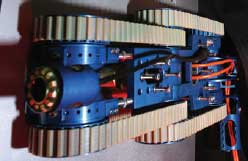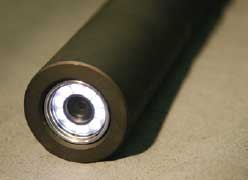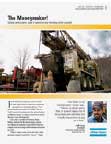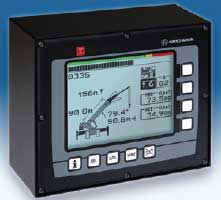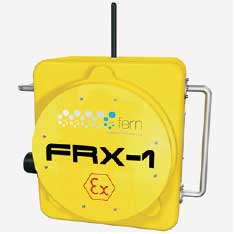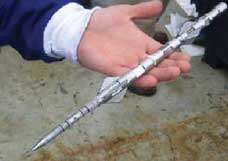New products
Remote inspection tool
Integrity, inspection and corrosion specialist iicorr Ltd has launched its Magnetic Crawler tool, designed for inspecting inaccessible or difficult-to-access areas. Magnets enable the robot to attach itself, and it uses integrated video and UT capabilities to examine areas at risk of corrosion. The Magnetic Crawler evolved from the company’s Trac-scan Crawler system, and is designed to assure jacket leg, riser and caisson integrity. Although initially designed for inspection on large-bore jacket legs and areas underneath external clamps, it can also remotely inspect large tanks, pipe work and subsea structures. The system has real-time viewing as well as data recording functions, and can be run remotely up to 200 m from the access point. It is rated for use in up to 200 m of water, and can fit through access points as small as 200 mm x 150 mm.
HPHT downhole camera
EV Offshore Ltd has announced the development of the EVOLeye HPHT 200 camera inspection system, the first of its kind to capture images in real time under high pressure and high temperature conditions downhole. The system is scheduled to be fully operational during Q1 2008. Following the initial launch of the camera, the company plans to release the Acoustic Module, which will make it possible to produce imaging in zero visibility. The Acoustic Module is designed using the same telemetry as featured in the Video Module. Both modules complement the system, and will be available as optional extras.
Water-based mud system The TERRA-MAX system is a high-performance water-based mud specifically designed to deliver improved drilling and environmental performance in a low-salinity environment. The system combines fluid technologies to deliver total inhibition of formations encountered in onshore and inland water drilling applications. The system is customized to address the specific drilling concerns of a given well, with the aim of delivering all drilling objectives with improved performance compared to conventional water-base mud systems, allowing its use in challenging drilling operations that previously required the use of invert-emulsion fluids. The system provides excellent wellbore stability; superior clay inhibition; enhanced ROP; effective cuttings encapsulation; reduced sticking; and reduced environmental impact, dilution rates and disposal costs.
Drilling application report series
Atlas Copco Drilling Solutions is now publishing a series of application reports focusing on drilling sites throughout the world where the Atlas Copco RD20 drilling rigs are being used. The two- to four-page reports in the Atlas Copco Application Report Series summarize the advantages of the truck-mounted rotary, deep-hole drill used in coalbed methane and natural gas drilling. The first three reports in the series document the use of the rig in the Appalachian Mountains by three different companies. Reports include site photography and comments from the drilling company president or site supervisor. The company is in the process of publishing additional reports in the series featuring various drill sites throughout the world.
Sand control solutions Halliburton announced three new screen solutions for sand control. Wells are often drilled in formations prone to unwanted water or gas production, which displaces hydrocarbon flow. In conventionally completed wells, water or gas breakthrough is addressed through remedial treatments. The EquiFlow Oil Selector helps to prevent unwanted water or gas from entering the production string. Horizontal completions increase contact with the reservoir, but there is the risk of water or gas breakthrough. The design of the EquiFlow inflow control device helps maintain optimum reservoir contact with horizontal wells by delaying water or gas breakthrough to increase productivity and ultimate reservoir. The PetroGuard Advanced Mesh screen technology resists plugging in heavy oil and also in variable-quality pay sands that would otherwise require the more complex gravel pack installation.
Shallow-water production control VetcoGray, a GE Oil & Gas business, has introduced a new production control system product. The PCS 1000 is a complete control system comprising both topside and subsea-located hardware, combined with the necessary software. The product features the company’s deepwater ModPod technology repackaged in a standardized, cost-effective format. This control system has been installed for deepwater projects worldwide, including the Burullus Gas “Simian-Sienna-Sapphire” project and the Esso Exploration Angola Ltd “Mondo” and “Saxi-Batique” projects. The device features an electrohydraulic subsea control module for the control and monitoring of subsea valves and sensors. The module is designed for a diver-assisted subsea installation, and a design option for ROV-operated interfaces is also available. A 19-in., rack-mounted master control station (MCS) provides control for up to six subsea wells. The MCS provides the operator interface as well as control logic, interlocks and event logging. The standard system is non-redundant, with a redundant PC configuration as an option. It is suitable for any subsea field development up to 300 m in water depth.
Mobile crane monitor
Hirschmann Automation and Control has introduced the iVISOR mentor QVGA (graphic) load moment indicator for mobile cranes. The unit provides the operator with a graphic display of the crane and the current load and geometric information, including the actual and allowable load, boom length, boom angle and load radius. The display also includes an integrated bar graph, which provides the operator with information on the cranes’ utilization. The display has a resolution of 320 x 240 pixels and includes BestVIEW technology to automatically adjusts the contrast depending on the temperature and lighting conditions. The system’s central processing unit and operators’ console are integrated into one compact unit. In addition to the programmable control functionality, two CANopen interfaces enable networking with other controls and displays.
Portable radio repeater
Fern Communications Ltd, a provider of two-way radio communications systems to the international upstream oil and gas industries, has introduced the FRX-1 ATEX Portable Radio Repeater. The new lightweight ATEX-certified repeater significantly increases radio coverage both on and offshore by eliminating radio black spots that disrupt radio signals, interrupting the flow of radio communications. FRX-1 is the only system of its kind that effectively bends the radio signal around a solid structure so that it reaches its target destination-the receiving radio located on the other side of the structure. The system is approved for use by the European Union in hazardous Zones 1 and 2, gas group 11C and is temperature-rated to T5. The unit operates on VHF, marine and UHF frequencies, so that it is fully compatible with existing radio communications systems currently in use offshore. The four-position channel switch makes it possible to select one of four frequencies, which is very useful at busy sites where frequencies are often shared. Using CTCSS and DCS, users can also share frequencies with other radio users in privacy. The output power can be set to between 1W and 5W. Weighing just 14kg, the FRX-1 is lightweight and extremely compact so that it can be easily used and positioned on platforms, rigs and FPSOs. Using a high-capacity Li-lon battery, it can operate for more than 18 hours before charging. Auxiliary batteries are available.
Small-diameter capillary injection systems
BJ Services has introduced its Dyna-Coil systems, offering effective artificial lift technology that uses small-diameter capillary strings through well tubing to feed specialty chemicals, water and solvents to enhance production. The capillary strings can be run to depths of 22,000 ft. Custom software is used to help select the most appropriate wells for these applications. More than 7,000 capillary strings using the technology have been installed throughout Canada and the US, including Alaska and the Gulf of Mexico, to help maintain production and increase recovery from mature fields, particularly in low-pressure gas reservoirs. One unique capability is the InjectSafe wireline-retrievable or tubing-retrievable SCSSVs (surface-controlled subsurface safety valves). Both designs allow operators to feed chemicals through a capillary system without violating the integrity of the SCSSV. For example, wells with liquid loading, salting, scaling or hydrate problems can be treated precisely, at the perforations, without pulling the tubing to install a capillary string. Using capillary strings in conjunction with the safety valve technology can produce significant production improvements in gas wells suffering from liquid loading. The InjectSafe system can be used to inject a variety of chemicals, such as surfactants and foamers for deliquification in gas wells. Chemical inhibitors can be injected to protect tubulars from corrosion and scale deposits, or to inhibit precipitation of salts, asphaltenes and paraffin in the tubing and SCSSV. By injecting de-emulsifying chemical at the perforations, emulsions are much less likely to form. .
|
|||||||||||||||||


